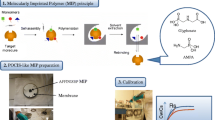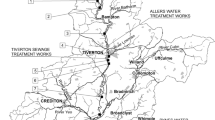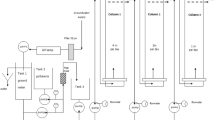Abstract
Polar organic chemical integrative samplers (POCIS) are widely used to track contaminants in surface waters. However, POCIS have not been used previously to monitor for artificial sweeteners as an indicator of wastewater pollution. In this study, we report for the first time the POCIS sampling rates (Rscal) for four artificial sweetener compounds, acesulfame (0.001 L/day), sucralose (0.114 L/day), cyclamate (0.001 L/day), and saccharin (0.002 L/day). We also prepared a modified POCIS with Strata X-AW anion exchange resin as a sorbent (i.e., ax-POCIS) and determined the sampling rates for sucralose (0.060 L/day) and acesulfame (0.128 L/day). Rscal values were adjusted according to the rate of loss of the performance reference compound, metoprolol-d6 from deployed POCIS to yield field sampling rates (i.e., Rsfield). Field validation of the monitoring method was conducted in Presqu’ile Bay on the north-central coast of Lake Ontario that is impacted by discharges from a sewage lagoon. POCIS were deployed at four sites within the bay and in the lagoon discharge. The four artificial sweeteners, as well as caffeine, ibuprofen, and other microcontaminants of sewage origin, were present throughout the bay at estimated concentrations in the ng/L range, and in the lagoon discharge at estimated concentrations higher by approximately one order of magnitude. Because acesulfame is present in ionic form over the pH range of natural waters, there are uncertainties related to the sampling rates using the standard POCIS. Sucralose is recommended as the best choice for source tracking using POCIS. There was good agreement between the concentrations of sucralose estimated from POCIS and the measured concentrations in grab samples of surface water in the bay. The present study provides key data for monitoring artificial sweeteners using POCIS.



Similar content being viewed by others
Availability of data
The data are available upon request from either of the two corresponding authors.
References
Alvarez, D. A., Stackelberg, P. E., Petty, J. D., Huckins, J. N., Furlong, E. T., Zaugg, S. D., & Meyer, M. T. (2005). Comparison of a novel passive sampler to standard water-column sampling for organic contaminants associated with wastewater effluents entering a New Jersey stream. Chemosphere, 61, 610–622.
Bailly, E., Levi, Y., & Karolak, S. (2013). Calibration and field evaluation of polar organic chemical integrative sampler (POCIS) for monitoring pharmaceuticals in hospital wastewater. Environmental Pollution, 174, 100–105.
Batchu, S. R., Quinete, N., Panditi, V. R., & Gardinali, P. R. (2013). Online solid phase extraction liquid chromatography tandem mass spectrometry (SPE-LC-MS/MS) method for the determination of sucralose in reclaimed and drinking waters and its photodegradation in natural waters from South Florida. Chemistry Central Journal, 7, 41–50.
Benoit, N. (2016). Presqu’ile Bay water quality study 2013. Ontario Ministry of Environment and Climate Change, Toronto, ON, Canada, 51 pages plus appendixes.
Benoit, N. (2020). Presqu’ile Bay water quality study. Summary of water quality conditions in 2015. Ontario Ministry of Environment Conservation and Parks, Toronto, ON, Canada, 38 pages plus appendixes.
Buerge, I. J., Buser, H. R., Kahle, M., Muller, M. D., & Poiger, T. (2009). Ubiquitous occurrence of the artificial sweetener acesulfame in aquatic environment: An ideal chemical marker of domestic wastewater in groundwater. Environmental Science & Technology, 43, 4381–4385.
Challis, J. K., Hanson, M. L., & Wong, C. S. (2018). Pharmaceuticals and pesticides archived on polar passive sampling devices can be stable for up to 6 years. Environmental Toxicology and Chemistry, 37, 762–767.
Daneshvar, A., Aboulfadl, K., Viglino, L., Broseus, R., Sauvé, S., & Madoux-Humery, A. S. (2012). Evaluating pharmaceuticals and caffeine as indicators of fecal contamination in drinking water sources of the Greater Montreal region. Chemosphere, 88, 131–139.
Ferreira, A. P., de Lourdes, C., & da Cunha, N. (2005). Anthropic pollution in aquatic environment: Development of a caffeine indicator. International Journal of Environmental Health Research, 15, 303–311.
Ferrer, I., & Thurman, E. M. (2010). Analysis of sucralose and other sweeteners in water and beverage samples by liquid chromatography/time-of-flight-mass spectrometry. Journal of Chromatography A, 1217, 4127–4124.
Gan, Z., Sun, H., Feng, B., Wang, R., & Zhang, Y. (2013). Occurance of seven artificial sweeteners in the aquatic environment and precipitation of Tianjin, China. Water Research, 47, 4928–4937.
Gao, P., Ding, Y., Li, H., & Xagoraraki, I. (2012). Occurrence of pharmaceuticals in a municipal wastewater treatment plant: Mass balance and removal processes. Chemosphere, 88, 17–24.
Harman, C., Allan, I. J., & Vermierssen, E. L. M. (2012). Calibration and use of the polar organic chemical integrative sampler – A critical review. Environmental Toxicology and Chemistry, 31, 2724–2738.
Hollender, J., Zimmermann, S. G., Koepke, S., Krauss, M., McArdell, C. S., Ort, C., Singer, H., von Gunten, U., & Siegrist, H. (2009). Elimination of organic micropollutants in a municipal wastewater treatment plant upgraded with full scale post ozonation followed by sand filtration. Environmental Science and Technology, 43, 7862–7869.
Huckins, J. N., Tubergen, M. W., & Manuweera, G. K. (1990). Semipermeable membrane devices containing model lipid: A new approach to monitoring the bioavaiiability of lipophilic contaminants and estimating their bioconcentration potential. Chemosphere, 20, 533–545.
Jacquet, R., Miege, C., Bados, P., Schiavone, S., & Coquery, M. (2012). Evaluating the polar organic chemical integrative sampler for the monitoring of beta blockers and hormones in wastewater treatment plants effluents and receiving surface waters. Environmental Toxicology and Chemistry, 31, 279–288.
Li, H., Helm, P., & Metcalfe, C. D. (2010). Sampling in the Great Lakes for pharmaceuticals, personal care products, and endocrine disrupting substances using the passive polar organic chemical integrative sampler. Environmental Toxicology and Chemistry, 29, 751–762.
Loos, R., Gawlik, B. M., Boettcher, K., Locoro, G., Contini, S., & Bidoglio, G. (2009). Sucralose screening in European surface waters using a solid-phase extraction-liquid chromatography–triple quadrupole mass spectrometry method. Journal of Chromatography A, 1216, 1126–1131.
Magi, E., Di Carro, M., Mirasole, C., & Benedetti, B. (2018). Combining passive sampling and tandem mass spectrometry for the determination of pharmaceuticals and other emerging pollutants in drinking water. Microchemical Journal, 136, 56–60.
Mawhinney, D. B., Young, R. B., Vanderford, B. J., Borch, T., & Snyder, S. A. (2011). Artificial sweetener sucralose in U.S. drinking water systems. Environmental Science & Technology, 45, 8716–8722.
Mazzella, N., Lissalde, S., Moreira, S., Delmas, F., Mazzelier, P., & Huckins, J. N. (2010). Evaluation of the use of performance reference compounds in an Oasis-HLB adsorbent based passive sampler for improving water concentration estimates of polar herbicides in freshwater. Environmental Science & Technology, 44, 1713–1719.
McCallum, E. S., Nikel, K. E., Mehdo, H., Du, S. N., Bowman, J. E., Midwood, J. D., Kidd, K. A., Scott, G. R. & Balshine, S. (2019). Municipal wastewater effluent affects fish communities: A multi-year study involving two wastewater treatment plants. Environmental Pollution, 252(Part B), 1730–1741.
Meçzykowska, H., Kobylis, P., Stepnowski, P., & Caban, M. (2017). Calibration of passive samplers for the monitoring of pharmaceuticals in water - sampling rate variation. Critical Reviews in Analytical Chemistry, 47, 204–222.
Metcalfe, C. D., Hoque, M. E., Sultana, T., Murray, C., Helm, P., & Kleywegt, S. (2014). Monitoring for contaminants of emerging concern in drinking water using POCIS passive samplers. Environmental Science: Processes & Impacts, 16, 473–481.
Miège, C., Mazzella, N., Allan, I., Dulio, V., Smedes, F., Tixier, C., Vermeirssen, E., Brant, J., O’Toole, S., Budzinski, H., Ghestem, J.-P., Staub, P.-F., Lardy-Fontan, S., Gonzalez, J.-L., Coquery, M., & Vrana, B. (2015). Position paper on passive sampling techniques for the monitoring of contaminants in the aquatic environment – Achievements to date and perspectives. Trends in Environmental and Analytical Chemistry, 8, 20–26.
Nevers, M. B., Byappanahallia, M. N., Edge, T. A., & Whitman, R. L. (2014). Beach science in the Great Lakes. Journal of Great Lakes Research, 40, 1–14.
Paerl, H. W., Gardner, W. S., Havens, K. E., Joyner, A. R., McCarthy, M. J., Newell, S. E., Qin, B., & Scott, T. (2016). Mitigating cyanobacterial harmful algal blooms in aquatic ecosystems impacted by climate change and anthropogenic nutrients. Harmful Algae, 54, 213–222.
Pasquini, L., Munoz, J. F., Rimlinger, N., Dauchy, X., France, X., Pons, M. N., & Görner, T. (2013). Assessment of the fate of some household micropollutants in urban wastewater treatment plant. Chemical Papers, 67, 601–612.
Schuerer, M., Brauch, H.-J., & Lange, T. (2009). Analysis and occurrence of seven artificial sweeteners in German wastewater and surface water and in soil aquifer treatment (SAT). Analytical and Bioanalytical Chemistry, 394, 1585–1594.
Soh, L., Connors, K. A., Brooks, B. W., & Zimmerman, J. (2011). Fate of sucralose through environmental and water treatment processes and impact on plant indicator species. Environmental Science & Technology, 45, 1363–1369.
Spoelstra, J., Schiff, S. L., & Brown, S. J. (2013). Artificial sweeteners in a large Canadian river reflect human consumption in the watershed. PLoS ONE, 8, e82706.
Sultana, T., Murray, C., Hoque, M. E., & Metcalfe, C. D. (2017). Monitoring contaminants of emerging concern from tertiary treatment plants using passive sampling modelled with performance reference compounds. Environmental Monitoring and Assessment, 189, 1–19.
Sultana, T., Murray, C., Kleywegt, S., & Metcalfe, C. D. (2018). Neonicotinoid pesticides in drinking water in agricultural regions of Ontario, Canada. Chemosphere, 202, 505–513.
Taylor, A. C., Fones, G. R., Vrana, B., & Mills, G. A. (2021). Applications for passive sampling of hydrophobic organic contaminants in water - A review. Critical Reviews in Analytical Chemistry, 51, 20–54.
Tollefsen, K. E., Nizzetto, L., & Huggett, D. B. (2012). Presence, fate and effects of the intense sweetener sucralose in the aquatic environment. Science of the Total Environment, 438, 510–516.
Tran, N. H., Yew-Hoong Gin, K., & Ngoc, H. H. (2015). Fecal pollution source tracking toolbox for identification, evaluation and characterization of fecal contamination in receiving urban surface waters and groundwater. Science of the Total Environment, 538, 38–57.
Vanderford, B. J., Mawhinney, D. B., Trenholm, R. A., Zeigler-Holaday, J. C., & Snyder, S. A. (2011). Assessment of sample preservation techniques for pharmaceuticals, personal care products, and steroids in surface and drinking water. Analytical and Bioanalytical Chemistry, 399, 2227–2234.
Van Stempvoort, D. R., Roy, J. W., Brown, S. J., & Bickerton, G. (2011). Artificial sweeteners as potential tracers in groundwater in urban environments. Journal of Hydrology, 401, 126–133.
Yang, Y.-Y., Zhao, J.-L., Liu, Y.-S., Liu, W.-R., & Q-Q., Yao, L., Hu, L-X., Zhang, J-N., Jiang, Y-X. & Ying, G-G. (2018). Pharmaceuticals and personal care products (PPCPs) and artificial sweeteners (ASs) in surface and ground waters and their application as indication of wastewater contamination. Science of the Total Environment, 616–617, 816–823.
Acknowledgements
This project was supported by a Discovery Grant to CDM from the Natural Sciences and Engineering Research Council (NSERC) of Canada. We thank Dr. Roger Green for his help in organizing the sampling campaign. Brenda Seaborn and Rosa Maria Nogeras helped with POCIS deployments and retrievals, and with the preparation of samples for analysis.
Funding
This project was supported by a Discovery Grant from the Natural Sciences and Engineering Research Council (NSERC) of Canada.
Author information
Authors and Affiliations
Contributions
Dr. Sultana was involved in the project conceptualization, data curation and analysis, investigation, methodology, and writing. Dr. Metcalfe was involved in the project administration, resources, supervision, funding, and writing.
Corresponding authors
Ethics declarations
Conflict of interest
The authors declare no competing interests.
Additional information
Publisher's Note
Springer Nature remains neutral with regard to jurisdictional claims in published maps and institutional affiliations.
Rights and permissions
About this article
Cite this article
Sultana, T., Metcalfe, C.D. Calibration and field validation of POCIS passive samplers for tracking artificial sweeteners as indicators of municipal wastewater contamination in surface waters. Environ Monit Assess 194, 564 (2022). https://doi.org/10.1007/s10661-022-10150-4
Received:
Accepted:
Published:
DOI: https://doi.org/10.1007/s10661-022-10150-4




